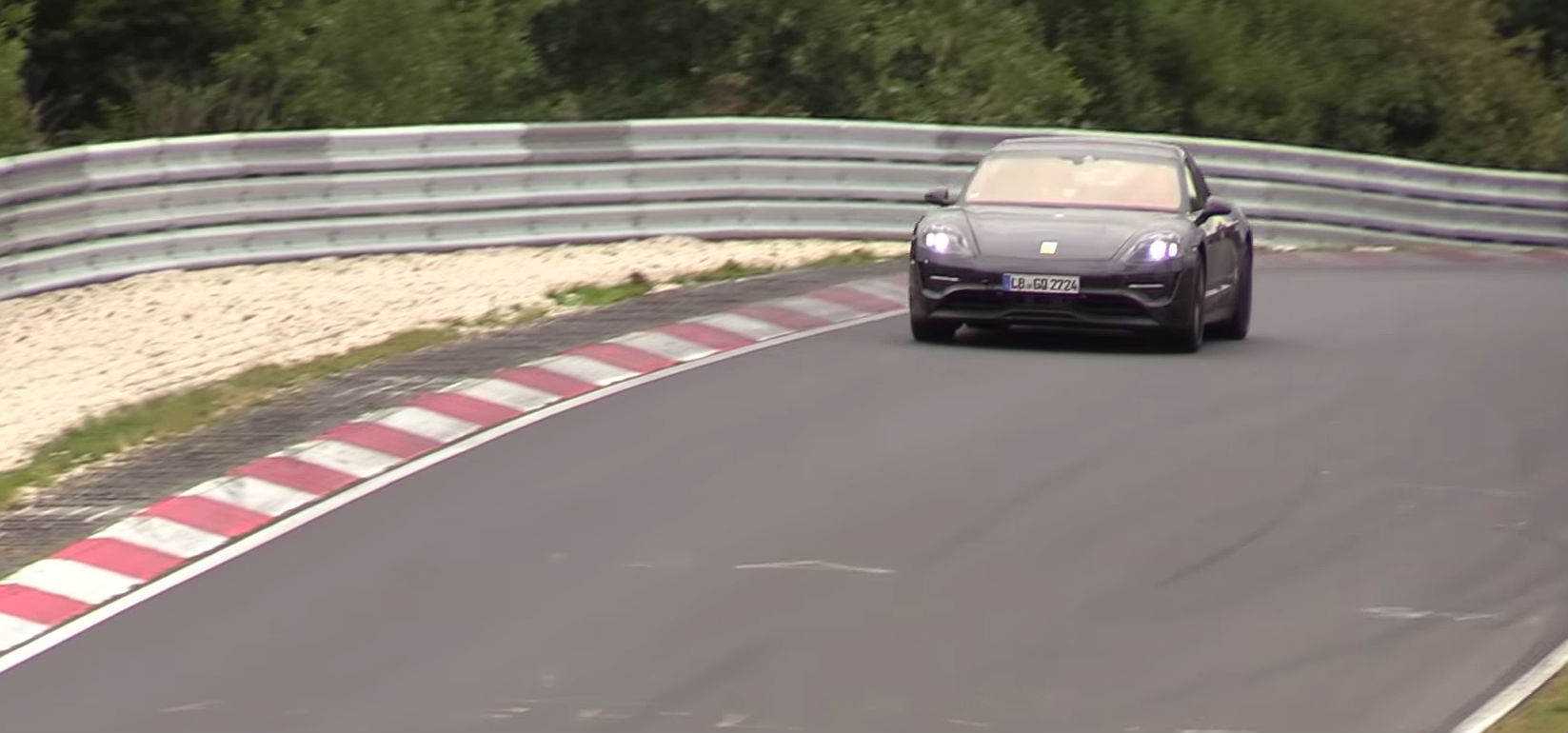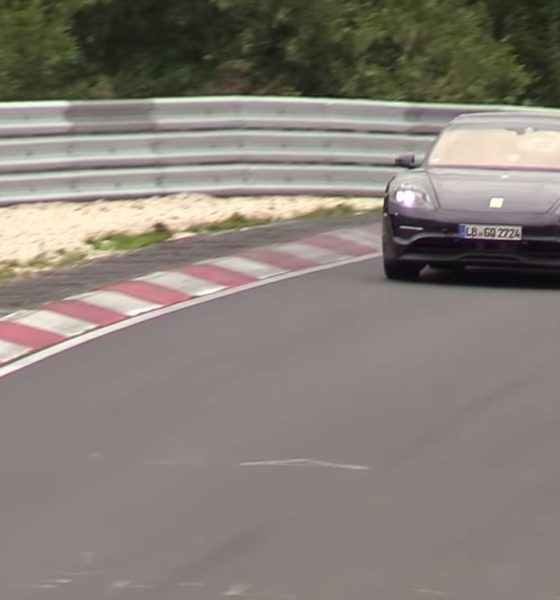

News
Porsche Taycan showcases track abilities beside high-performance cars in the Nurburgring
Porsche has been very vocal about its aim to ensure that the Taycan, its first all-electric car, would be at home on the racetrack. Porsche’s gasoline-powered cars are famed for their performance and their “soul,” and the company has maintained that the Taycan would be no different.
This means that the upcoming electric four-door sedan would have to be proficient and tuned enough to handle the world’s most challenging racecourses. To accomplish this, Porsche has been taking some of the Taycan’s camouflaged prototypes to one of Germany’s most iconic tracks — the Nurburgring. The intense, twisting 12.93-mile racetrack is famed for its difficulty, resulting in an adage which states that “if a vehicle runs on the Nurburgring, it can run anywhere.”
Just recently, the Porsche Taycan was sighted sharing the famous racetrack with some of Germany’s most iconic high-performance cars, as well as a number of fellow camouflaged prototypes from Audi, BMW, and Mercedes-Benz, to name a few. A video of the vehicles was posted by YouTube’s cvdzijden – Supercar Videos channel, which shares clips of vehicle testing sessions in the racetrack.
The recent Nurburgring session is part of the Industry Pool, an initiative that involves more than two dozen OEMs, all of which combine financial resources to rent out the racetrack four days a week, 16 weeks a year (usually two weeks/month between April and October). In true Industry Pool fashion, several unreleased vehicles could be seen aggressively tackling the turns of the track, but among all of the cars, the Taycan stands apart due to its stealthy way of hugging turns and then exploding forward with its instant torque.
Porsche’s approach to refining the track capabilities of the Taycan is indicative of its experience in the auto industry. Over the past months, the automaker has been taking its camouflaged Taycan prototypes to the Nurburgring for track sessions. This approach seems to be a little bit different from Tesla and its Track Mode for the Model 3 Performance, which was largely developed in-house and heavily software-based. Tesla CEO Elon Musk dubbed Track Mode as an “Expert User Mode” for the electric car, in the way that it would allow drivers to tweak their vehicles’ settings according to their preferences.
The Porsche Taycan is expected to be marketed as a competitor for the Tesla Model S, but its listed specs are more comparable to the Model 3 Performance. The German automaker states that the Taycan would be able to accelerate from 0-60 mph in 3.5 seconds, eventually hitting a top speed of 155 mph. The vehicle is also expected to feature a 310-mile range per charge, and it would be supported by Porsche’s upcoming Charge Parks, a fast-charging network not unlike Tesla’s Superchargers.
Porsche seems to be the one legacy automaker that is really committed to its electric car push. While companies like Jaguar and Mercedes-Benz have released electric vehicles, neither one has announced a dedicated charging infrastructure for their cars. That said, this is not to say that everything about the Taycan is going well.
The company plans to build the Taycan at its Zuffenhausen facility in Stuttgart, Germany, a location that also manufactures the Porsche 911, 718 Boxster, and the 718 Cayman. Last July, Porsche head of production Albrecht Reimold noted that it is quite difficult to find a location to set up the Taycan’s assembly lines in the facility, especially considering the work that would have to be done to transform the factory and optimize it for the electric car’s production. Ultimately, Porsche aims to build 20,000 Taycans per year when the vehicle enters production, which is expected to begin in 2019.
Watch the Porsche Taycan fit right in with other high-performance cars in the video below.

News
Tesla is not sparing any expense in ensuring the Cybercab is safe
Images shared by the longtime watcher showed 16 Cybercab prototypes parked near Giga Texas’ dedicated crash test facility.

The Tesla Cybercab could very well be the safest taxi on the road when it is released and deployed for public use. This was, at least, hinted at by the intensive safety tests that Tesla seems to be putting the autonomous two-seater through at its Giga Texas crash test facility.
Intensive crash tests
As per recent images from longtime Giga Texas watcher and drone operator Joe Tegtmeyer, Tesla seems to be very busy crash testing Cybercab units. Images shared by the longtime watcher showed 16 Cybercab prototypes parked near Giga Texas’ dedicated crash test facility just before the holidays.
Tegtmeyer’s aerial photos showed the prototypes clustered outside the factory’s testing building. Some uncovered Cybercabs showed notable damage and one even had its airbags engaged. With Cybercab production expected to start in about 130 days, it appears that Tesla is very busy ensuring that its autonomous two-seater ends up becoming the safest taxi on public roads.
Prioritizing safety
With no human driver controls, the Cybercab demands exceptional active and passive safety systems to protect occupants in any scenario. Considering Tesla’s reputation, it is then understandable that the company seems to be sparing no expense in ensuring that the Cybercab is as safe as possible.
Tesla’s focus on safety was recently highlighted when the Cybertruck achieved a Top Safety Pick+ rating from the Insurance Institute for Highway Safety (IIHS). This was a notable victory for the Cybertruck as critics have long claimed that the vehicle will be one of, if not the, most unsafe truck on the road due to its appearance. The vehicle’s Top Safety Pick+ rating, if any, simply proved that Tesla never neglects to make its cars as safe as possible, and that definitely includes the Cybercab.
Elon Musk
Tesla’s Elon Musk gives timeframe for FSD’s release in UAE
Provided that Musk’s timeframe proves accurate, FSD would be able to start saturating the Middle East, starting with the UAE, next year.

Tesla CEO Elon Musk stated on Monday that Full Self-Driving (Supervised) could launch in the United Arab Emirates (UAE) as soon as January 2026.
Provided that Musk’s timeframe proves accurate, FSD would be able to start saturating the Middle East, starting with the UAE, next year.
Musk’s estimate
In a post on X, UAE-based political analyst Ahmed Sharif Al Amiri asked Musk when FSD would arrive in the country, quoting an earlier post where the CEO encouraged users to try out FSD for themselves. Musk responded directly to the analyst’s inquiry.
“Hopefully, next month,” Musk wrote. The exchange attracted a lot of attention, with numerous X users sharing their excitement at the idea of FSD being brought to a new country. FSD (Supervised), after all, would likely allow hands-off highway driving, urban navigation, and parking under driver oversight in traffic-heavy cities such as Dubai and Abu Dhabi.
Musk’s comments about FSD’s arrival in the UAE were posted following his visit to the Middle Eastern country. Over the weekend, images were shared online of Musk meeting with UAE Defense Minister, Deputy Prime Minister, and Dubai Crown Prince HH Sheikh Hamdan bin Mohammed. Musk also posted a supportive message about the country, posting “UAE rocks!” on X.
FSD recognition
FSD has been getting quite a lot of support from foreign media outlets. FSD (Supervised) earned high marks from Germany’s largest car magazine, Auto Bild, during a test in Berlin’s challenging urban environment. The demonstration highlighted the system’s ability to handle dense traffic, construction sites, pedestrian crossings, and narrow streets with smooth, confident decision-making.
Journalist Robin Hornig was particularly struck by FSD’s superior perception and tireless attention, stating: “Tesla FSD Supervised sees more than I do. It doesn’t get distracted and never gets tired. I like to think I’m a good driver, but I can’t match this system’s all-around vision. It’s at its best when both work together: my experience and the Tesla’s constant attention.” Only one intervention was needed when the system misread a route, showcasing its maturity while relying on vision-only sensors and over-the-air learning.
News
Tesla quietly flexes FSD’s reliability amid Waymo blackout in San Francisco
“Tesla Robotaxis were unaffected by the SF power outage,” Musk wrote in his post.

Tesla highlighted its Full Self-Driving (Supervised) system’s robustness this week by sharing dashcam footage of a vehicle in FSD navigating pitch-black San Francisco streets during the city’s widespread power outage.
While Waymo’s robotaxis stalled and caused traffic jams, Tesla’s vision-only approach kept operating seamlessly without remote intervention. Elon Musk amplified the clip, highlighting the contrast between the two systems.
Tesla FSD handles total darkness
The @Tesla_AI account posted a video from a Model Y operating on FSD during San Francisco’s blackout. As could be seen in the video, streetlights, traffic signals, and surrounding illumination were completely out, but the vehicle drove confidently and cautiously, just like a proficient human driver.
Musk reposted the clip, adding context to reports of Waymo vehicles struggling in the same conditions. “Tesla Robotaxis were unaffected by the SF power outage,” Musk wrote in his post.
Musk and the Tesla AI team’s posts highlight the idea that FSD operates a lot like any experienced human driver. Since the system does not rely on a variety of sensors and a complicated symphony of factors, vehicles could technically navigate challenging circumstances as they emerge. This definitely seemed to be the case in San Francisco.
Waymo’s blackout struggles
Waymo faced scrutiny after multiple self-driving Jaguar I-PACE taxis stopped functioning during the blackout, blocking lanes, causing traffic jams, and requiring manual retrieval. Videos shared during the power outage showed fleets of Waymo vehicles just stopping in the middle of the road, seemingly confused about what to do when the lights go out.
In a comment, Waymo stated that its vehicles treat nonfunctional signals as four-way stops, but “the sheer scale of the outage led to instances where vehicles remained stationary longer than usual to confirm the state of the affected intersections. This contributed to traffic friction during the height of the congestion.”
A company spokesperson also shared some thoughts about the incidents. “Yesterday’s power outage was a widespread event that caused gridlock across San Francisco, with non-functioning traffic signals and transit disruptions. While the failure of the utility infrastructure was significant, we are committed to ensuring our technology adjusts to traffic flow during such events,” the Waymo spokesperson stated, adding that it is “focused on rapidly integrating the lessons learned from this event, and are committed to earning and maintaining the trust of the communities we serve every day.”








